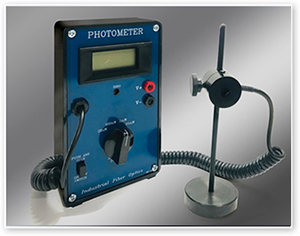|
Digital Photometer Photometers are essential equipment in any in-school research or technical principles programs. A versatile and economical classroom tool for measuring power levels of laser beams, demodulating optical signals for audio applications and solar experiments. The battery power, portability and adjustable height detector head of this model offer particular flexibility. The photometer is powered by two standard 9-volt batteries and offers four digital measurement scales from 20 microWatts through 20 milliWatts. Output to industry-standard banana jacks is a conditioned electrical voltage that is directly proportional to light incident upon the photodetector with a frequency range up to 10 kHz. (The analog output can be connected to a strip chart recorder for solar monitoring, to an oscilloscope for observing time-dependent optical signals or to an amplified speaker for voice transmission.) The photometer will also act as output to industry-standard banana jacks. |

|
- Large, easy-to-read digital display
- Four measurement scales from 20 microwatts to 20 milliwatts
- Large active area detector
- Sensitive to visible and IR light
- Battery operation for portability (100-plus hours operation)
- Momentary switch for long battery life
- Adjustable detector height
- Impact-resistant enclosure
- All solid state detector with electronic design
Photometer comes complete with storage container, metal optical stand for the detector, instruction manual and batteries. The housing is 16 x 9.5 x 6.5 cm in size. Operating temperature is 10-30 ° C
LASER CLASSIFICATIONS
All manufacturers of lasers used in the United States, must conform to regulations administered by the Center for Devices and Radiological Health (CDRH), a branch of the U.S. Department of Health and Human Services. CDRH categorizes lasers as follows:
A laser or laser system which does not present a hazard to skin or eyes for any wavelength or exposure time. Exposure varies with wavelength. For ultraviolet, .2 to .4µm exposure is less than from .8 or near IR, the exposure is < 200µw. Consult CDRH regulations for specific information.
Any visible laser with an output less than 1 mW of power. Warning label requirements - yellow caution label stating maximum output of 1 mW. Generally used as classroom lab lasers, supermarket scanners and laser pointers.
Any visible laser with an output over 1 mW of power with a maximum output of 5 mW of power. Warning label requirements - red danger label stating maximum output of 5 mW. Also used as classroom lab lasers, in holography, laser pointers, leveling instruments, measuring devices and alignment equipment.
Any laser with an output over 5 mW of power with a maximum output of 500 mW of power and all invisible lasers with an output up to 400 mW. Warning label requirements - red danger label stating maximum output. These lasers also require a key switch for operation and a 3.5-second delay when the laser is turned on. Used in many of the same applications as the Class IIIa when more power is required.
Any laser with an output over 500 mW of power. Warning label requirements - red danger label stating maximum output. These lasers are primarily used in industrial applications such as tooling, machining, cutting and welding. Most medical laser applications also require these high-powered lasers.

 Industrial Fiber Optics, Inc
Industrial Fiber Optics, Inc

 Mountain Standard Time
Mountain Standard Time